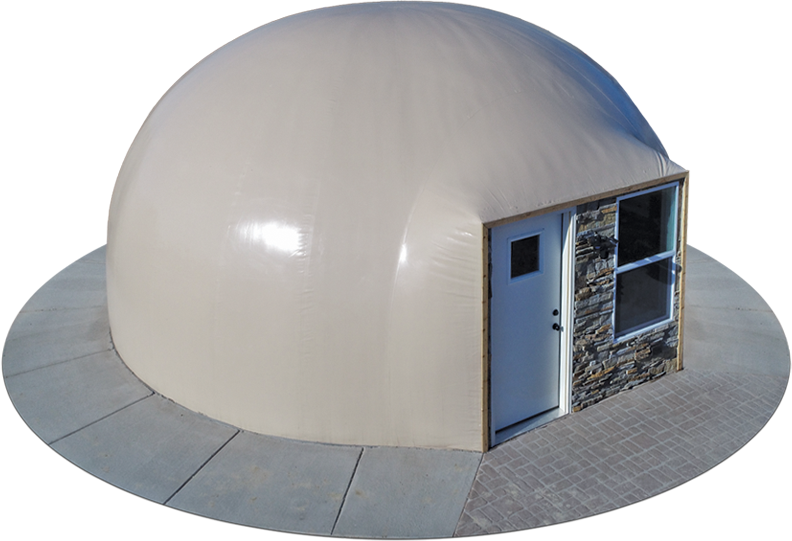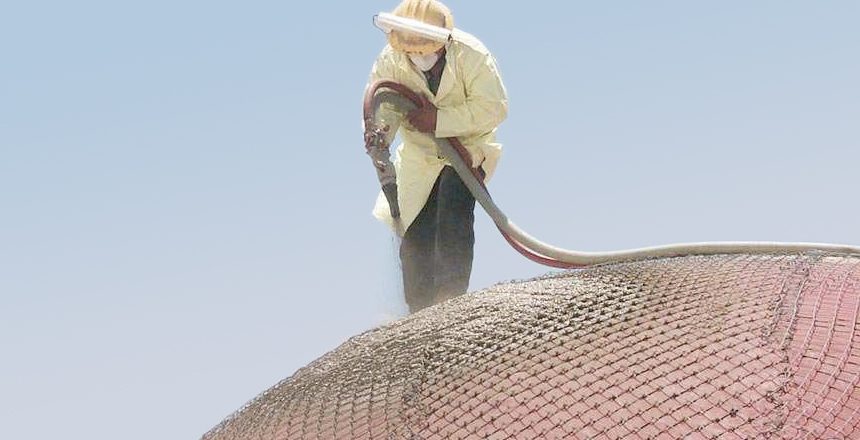Like any new home construction, there are a lot of exciting decisions to make when building a dome home! One that might not immediately come to mind—but is extremely important—is how to protect the exterior layer from prolonged exposure to the elements. The inherent structure of a dome provides extraordinary strength and durability. However, we recommend treating its exterior with a protective layer to ensure the outer shell, called an airform, lasts as long as the dome itself.
During the early stages of dome construction, an airform is like a giant balloon, which gets inflated to become the outer shell. It is an essential element of the overall structure that protects the underlying polyurethane foam from differing weather conditions. But over time, sunshine will degrade the airform just like any building exterior, so we recommend adding a protective layer. And just like traditional roofing materials, you have options when choosing how to protect an airform.
Choosing the Right Protective Layer
With a wide variety of protective layers to choose from, you can protect your dome home’s outer shell in whatever way best suits your needs, environment, or aesthetic preference. But while the airform can withstand years of weather without significant damage, we highly recommend a protective layer to ensure the exterior of the dome lasts as long as the dome itself.
We have created this guide with our recommended options to make it easy to choose the right protective layer for your dome home. Consider the benefits along with the unique features and design elements of each.
Primer as a Protective Layer
An airform is made from PVC that has chemicals added to make it flexible. These chemicals are called plasticizers, but they dry out over time, compromising the airform.
A thin coat of primer is all that’s needed to lock the plasticizers in the Airform, greatly prolonging its life. It can be applied to the exterior, interior, or both and dries clear. When applied to the interior of the airform (before applying the insulating foam), primer seals the airform and the polyurethane foam together, eliminating the chance of air bubbles forming between the two surfaces.
Pros
- It seals on both sides of the airform
- It’s inexpensive
- Bonds the layers and prevents air bubbles from forming
Cons
- It dries clear, so it is less decorative
- It is very sticky during the drying process
- It does not provide as much protection from harsher elements
Chain Shell
A chain shell is a heavy-duty stucco applied to the dome’s exterior to protect the airform and polyurethane foam. It is very similar to the shotcrete used in other stages of dome construction.
To start this process, we cover the dome with a layer of chain link fencing, which is where we get the name “chain shell.” Then, we lay the “scratch coat,” a thin layer of concrete 1 to 1.25 inches thick, followed by a second and thinner protective layer of concrete to smooth the surface. Both applications take three to five weeks to cure. The last coat applied is an even thinner layer of concrete, which can incorporate optional designs.
Chain shells can protect an airform from fire, sun, natural disasters, and other severe damage. Unfortunately, it does not provide the ultimate waterproofing.
Pros
- It is fire-resistant
- It facilitates optional custom design elements
- It adds an added degree of structural integrity
Cons
- It is not 100% waterproof
- It requires extensive curing times between each layer
Tile or Rock
The most intricate and unique way to finish your dome is with tile or rock, and both provide a gorgeous finish!
When tiling, the size of the dome and its overall curvature determines the size of the tiles used. Our goal is to create little to no space between the airform and the tiling, so we must avoid any edges sticking out from the dome’s surface. And the calculative process to make this a reality is very complex.
Industry best practices show that the best tiles for this application are porcelainized tiles or any tile designed for outdoor use. Both are weather-proof and made specifically for outdoor use. You may also choose any variation of stones, rocks, or marbles for the protective layer, secured to the airform using a strong adhesive in the same way as the tiles.
Pros
- Provides the most customization
- Weather protection
Cons
- The size of tiles or rocks used must be compatible with the curvature of the dome
Ceramic Coating
A ceramic coating is a thick shell across the surface of your dome. This technology has been around since 1970 and has been used on many structures since.
The application process of ceramic coating is straightforward and only requires two layers to establish an effective weatherproof seal. Additionally, ceramic coating can be applied in a variety of colors.
Pros
- It is a relatively inexpensive and straightforward treatment
- It provides design flexibility for the protective layer
Cons
- It does not provide added insulation
- It is not easy to touch up
Tour Our Demo Dome
Domes are gaining in popularity around the country. To see a dome for yourself, schedule a tour of our demo dome in Sioux Falls by clicking here or calling 605-368-5477 today!




